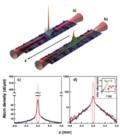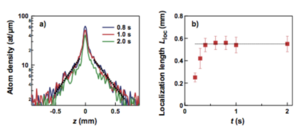L-7: Difference between revisions
| Line 2: | Line 2: | ||
== The Gaussian packet of free particles: the ballistic behaviour == | == The Gaussian packet of free particles: the ballistic behaviour == | ||
The Schrodinger equation govern the evolution of the quantum state of a particle | |||
<center><math> i\hbar \partial_t \psi(x,t) = H \psi(x,t), \quad H= -\frac{\hbar^2}{2 m} \frac{d^2}{dx^2} +V(x) </math></center> | |||
Here <math> H </math> is the Hamiltonian and for free particle we assume <math> V(x) =0</math> | |||
In this case the separable (or the eigenstate) solution has the form | |||
<center><math> \psi_k(x,t) =\frac{1}{\sqrt{2 \pi}} e^{i k x} e^{- i E_k t/\hbar},\quad \text{with} \; E_k =\frac{\hbar^2 k^2}{2 m} </math></center> | |||
Here <math>k </math> is a real number. These solutions are delocalized on the entire real axis and they cannot be normalized. | |||
However, physical solutions exist because, using the superposition principle, any linear combination of the separable solution is also a solution of the Schrodinger equation, even is is not separable. We can then costruct a localized wave packet, which can be normalized solution, but the physical property of the particle wi not be stationary in time. In particular we can write | |||
<center><math> \psi(x,t)=\int_{-\infty}^\infty d k c(k) \psi(x,t), \quad \text{with} \; \int_{-\infty}^\infty d k |c(k)|^1 =1</math></center> | |||
An example is the Gaussian packet of intial spread <math> a</math>: | |||
center><math> \psi(x,t)=\int_{-\infty}^\infty d k c(k) \psi(x,t), \quad \text{with} \; \int_{-\infty}^\infty d k |c(k)|^1 =1</math></center> | |||
Revision as of 12:11, 8 March 2024
Goal : This is the first lecture about the localization. Localization is a wave phenomenon induced by disorder.
The Gaussian packet of free particles: the ballistic behaviour
The Schrodinger equation govern the evolution of the quantum state of a particle
Here is the Hamiltonian and for free particle we assume In this case the separable (or the eigenstate) solution has the form
Here is a real number. These solutions are delocalized on the entire real axis and they cannot be normalized.
However, physical solutions exist because, using the superposition principle, any linear combination of the separable solution is also a solution of the Schrodinger equation, even is is not separable. We can then costruct a localized wave packet, which can be normalized solution, but the physical property of the particle wi not be stationary in time. In particular we can write
An example is the Gaussian packet of intial spread :
center>
The conductance and the diffusive behaviour
Ohm's laws characterize electric transport of (good or bad) conductors:
- First law:
Here is the resistence of the sample and is its conductance.\
- Second law
Here are the resistivity and the conductivity. These are material properties, independent of the geometry of the sample These phenomenological laws are a macroscpic manifestation of the diffusive motion of the electrons. From the Drude model we know that disorder is the crucial ingredient to justify the presence of diffusion. ]













